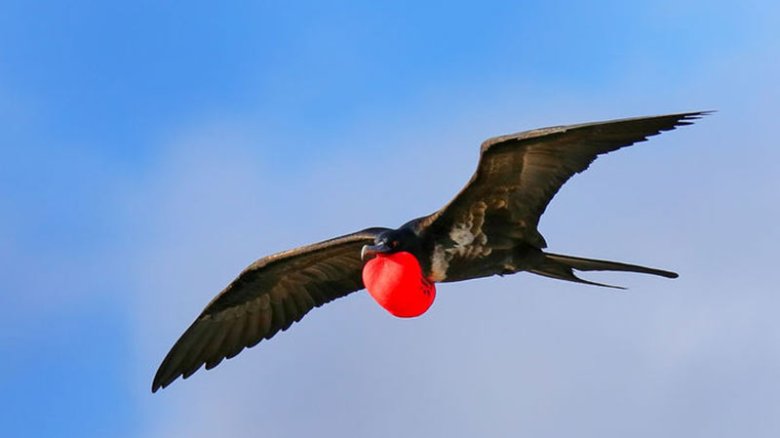Molokini bird watching is quite a thrill!
The Hawaii Audubon Society’s 1980 survey of Molokini’s bird populations found large numbers of two species, the Bulwer’s petrels and the wedge-tailed shearwaters. The birds fish out on the open ocean during the day and return home to their cliff burrows after sunset to feed their young. The eroding rock of Molokini’s high edge makes it easy for birds to carve out little nests. Just imagine – what a life – fishing all day, living without predators, and basking in the warm Hawaiian tradewinds by night with views of Maui, Moloka’i, Lana’i and Kaho’olawe islands. One can often spot both species from the tour boat while Molokini bird watching.

Male Great Frigatebird in flight over Molokini Crater
Brown Booby
These birds are sexually dimorphic, meaning that the differences between males and females extend beyond the sexual organs. Males and females both reach sizes of approximately 30 inches in length. Females have longer wingspans, and weigh slightly more than males. The birds have sharp beaks, short wings, and long tails. Brown boobies are strong fliers, and use Molokini’s strong gusts to assist them in taking off from the cliff ledge. Brown boobies eat fish and squid.
Wedge-Tailed Shearwater (‘Ua’u Kani)
Shearwaters can be found across the Pacific and Indian Oceans. These birds breed off Japan, Hawai’i, Australia, and the Seychelles. Those here in Hawai’i are the pale version of the species, with grey and brown plumage and white undersides. Shearwaters evolved a set of legs far back on the body, a positioning that enables them to swim. The wedge-tailed shearwaters eat mostly fish (especially goatfish), but also snack on crustaceans and squid.
Wedge-tailed shearwaters form monogamous, marriage-like bonds for several years. If the couple do not reproduce, the relationships dissolve. The birds even make their calls together, to communicate with their offspring and to warn of predators. The birds are known for their long calls; their Hawaiian name ‘ua’u nani means moaning bird. Look and listen for wedgies while Molokini bird watching!
Bulwer’s Petrel
Named after Scottish naturalist James Bulwer, these birds eat plankton from the surface of the ocean. A small bird, the petrel reaches lengths of 25 – 30 cm and wingspans of 80 – 90 centimeters. Bulwer’s petrels have pointed tails and long wings. They spend most of the year at sea, but breed in Hawaii, the North Pacific, and China.
